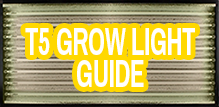 T5 light can come in various models, shapes and sizes and there are linear, circle, compact, two tube and so on bulbs. All these bulb shapes and sizes can be a big burden for any buyer wanting to choose the right fluorescent light. Each shape has its advantages and disadvantages and they vary in efficiency and usefulness and price so examine all these types before choosing your next fluorescent grow light. In this review lets try to examine each shape and format but also compare them for how well they work for growing plants.
T5 light can come in various models, shapes and sizes and there are linear, circle, compact, two tube and so on bulbs. All these bulb shapes and sizes can be a big burden for any buyer wanting to choose the right fluorescent light. Each shape has its advantages and disadvantages and they vary in efficiency and usefulness and price so examine all these types before choosing your next fluorescent grow light. In this review lets try to examine each shape and format but also compare them for how well they work for growing plants.
I will also provide some wattage and lumen outputs and the total lumen per watt efficiency rating but know that I took these from some standard bulbs and they may vary from one bulb to other and they should be taken just as a comparison.
CFL bulbs:
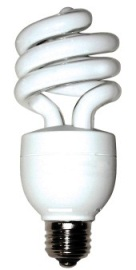 CFL or Compact fluorescent lights are curved fluorescent tubes compacted in a small space and fitted with portable ballast that allows them to be fitted in regular household light bulb sockets.
CFL or Compact fluorescent lights are curved fluorescent tubes compacted in a small space and fitted with portable ballast that allows them to be fitted in regular household light bulb sockets.
As Grow lights CFL bulbs have the advantages of being cheap , having easy and understandable technologies and also being compact. Because you can buy these light everywhere and everyone is using them in their home, you much rather have a well known technology than some outside ballasts and fixtures to worry about. And this is the major selling point on CFL bulbs but if we turn to what is better and more efficient for growing then CFL light do not look as good. These Compact Fluorescents lights are less efficient than almost any other fluorescent technology so they will use more electricity and won’t be able to supply as much light power to your plants for the same price as T5 or T8 bulbs. CFL bulbs are oddly shaped so reflectors can’t cover them fully and there is less light reflection from those reflectors. CFL bulbs are almost always available in small wattages so you will need to have a lot of those small bulbs to get some decent light penetration and growth! And when you can get them in bigger wattages they get more inefficient and that can become a big waste of electricity!
My final opinion about CFL bulbs is that they are good for small scale growers that want to try out growing something with artificial lights. Because there won’t be a lot of savings in efficiency and also for small scale you don’t need that much bulbs you can start your artificial light growing with CFL bulb. But if you are trying to grow larger crops or larger quantities than CFL lights become a huge waste of electricity and you need to do a lot of work to set them up!
CFL light Efficiency:
-
13 W = 825 lumen => 63 lumen/watt
-
26 W = 1610 lumen => 61 lumen/watt
-
42 W = 2700 lumen => 64 lumen/watt
-
45 W = 2800 lumen => 62 lumen/watt
-
85 W = 4250 lumen => 50 lumen/watt
-
125 W = 7,000 lumen => 56 lumen/watt
-
200 W = 9500 lumen => 47 lumen/watt
-
300 W = 13,975 lumen => 46 lumen/watt
T12 bulbs
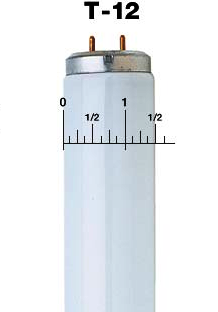 T12 fluorescent tubes are the oldest and most widely used fluorescent light and have been on the market for more than 60 years but because they are so old they can’t compete with the newer and more efficient fluorescent tubes. Basically T12 stands for the diameter of the bulbs and it is 1.5 inches (3.8 cm). These lights have a lower efficiency than T5 and T8 bulbs because that diameter of the bulb is wider and because many of the old T12 fixtures use old-style magnetic ballasts they are even more inefficient and have power losses transforming that voltage. Because these lights have been slowly phased out of the market I would not advise to grow your plants with them and they also give off more heat that would need ventilation and additional costs for you!
T12 fluorescent tubes are the oldest and most widely used fluorescent light and have been on the market for more than 60 years but because they are so old they can’t compete with the newer and more efficient fluorescent tubes. Basically T12 stands for the diameter of the bulbs and it is 1.5 inches (3.8 cm). These lights have a lower efficiency than T5 and T8 bulbs because that diameter of the bulb is wider and because many of the old T12 fixtures use old-style magnetic ballasts they are even more inefficient and have power losses transforming that voltage. Because these lights have been slowly phased out of the market I would not advise to grow your plants with them and they also give off more heat that would need ventilation and additional costs for you!
T12 light efficiency:
-
20 W 2 feet = 1200 lumen => 60 lumen/watt
-
40 W 4 feet = 3150 lumen => 79 lumen/watt
-
75 W 8 feet = 4500 lumen => 60 lumen/watt
T8 bulbs
 T8 light bulbs were the next generation after the initial T12 bulbs and they were introduced in the 1980’s giving significant efficiency increases and decreasing bulbs diameters. T8 bulbs are 1 inch (2.5 cm) thick so they have lower profile but they also have a cooler running temperature and give off lower amount of heat so they are better for growing plants indoors in hot environmental conditions. T8 lights are also cheap because they are the main lighting sources for many warehouses and shops. Because T8 light can replace T12 in the same light fixture they have become widely popular driving their price down to just about the same as T12 light so in the price point you better have the newest technology for the same price. And if you choose T8 light you should also know that they have better color rendering indexes and spectral output so the light that is produced by them is better and more useful for your plants. T8 lights also come in High output options that give you better light penetration and strength but can decrease the bulb life and they need special fixtures to fit them.
T8 light bulbs were the next generation after the initial T12 bulbs and they were introduced in the 1980’s giving significant efficiency increases and decreasing bulbs diameters. T8 bulbs are 1 inch (2.5 cm) thick so they have lower profile but they also have a cooler running temperature and give off lower amount of heat so they are better for growing plants indoors in hot environmental conditions. T8 lights are also cheap because they are the main lighting sources for many warehouses and shops. Because T8 light can replace T12 in the same light fixture they have become widely popular driving their price down to just about the same as T12 light so in the price point you better have the newest technology for the same price. And if you choose T8 light you should also know that they have better color rendering indexes and spectral output so the light that is produced by them is better and more useful for your plants. T8 lights also come in High output options that give you better light penetration and strength but can decrease the bulb life and they need special fixtures to fit them.
T8 light efficiency:
-
15 W 17 inch = 825 lumen => 55 lumen/watt
-
17 W 2 feet = 1325 lumen => 78 lumen/watt
-
28 W 40 inch = 2800 lumen => 100 lumen/watt
-
32 W 4 feet = 2950 lumen => 92 lumen/watt
-
59 W 8 feet = 5800 lumen => 98 lumen /watt
High Output bulbs
-
86 W 8 feet = 8000 lumen => 93 lumen/watt
-
44 W 4 feet = 4000 lumen => 91 lumen/watt
T5 bulbs
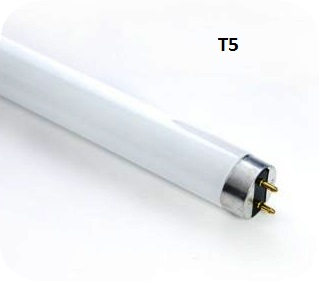 T5 light are the latest generation of fluorescent tubes and they are meant to replace those T8 bulbs in efficiency and give better light output. These T5 tubes have again smaller width and it is 0.62 inches (15.9 mm) so they are more compact and have lower overall profile. T5 ballasts are smaller and that is why T5 light fixtures can also be thinner than T8 ones. T5 lights are more efficient than T8 bulbs but not by much and they have about 10% increase in efficiency but their price is considerably higher and that can be an issue. T5 bulbs also run with higher temperature because they need to be around 35 Degrees Celsius to be the most efficient whereas T8 light run at around 28 degrees Celsius. This is not a huge increase but can again be a problem for small grow operations or Hotter climates. Overall T5 lights are the best solution for growing because they are more compact and more efficient and because of that you can cramp more of them in the same space and give your plants more intense light that also costs less watt per watt than any other fluorescent light source. T5 light bulbs come in different sizes and Wattage output but each different manufacturer has slightly different bulb efficiency so be careful when you are choosing your T5 fixture. T5 light bulbs also come in standard configuration and High Output configuration but they have another and that is the Very High output configuration but the that last is not feasible for growing because it is about 20 to 30 % less efficient than HO bulbs.
T5 light are the latest generation of fluorescent tubes and they are meant to replace those T8 bulbs in efficiency and give better light output. These T5 tubes have again smaller width and it is 0.62 inches (15.9 mm) so they are more compact and have lower overall profile. T5 ballasts are smaller and that is why T5 light fixtures can also be thinner than T8 ones. T5 lights are more efficient than T8 bulbs but not by much and they have about 10% increase in efficiency but their price is considerably higher and that can be an issue. T5 bulbs also run with higher temperature because they need to be around 35 Degrees Celsius to be the most efficient whereas T8 light run at around 28 degrees Celsius. This is not a huge increase but can again be a problem for small grow operations or Hotter climates. Overall T5 lights are the best solution for growing because they are more compact and more efficient and because of that you can cramp more of them in the same space and give your plants more intense light that also costs less watt per watt than any other fluorescent light source. T5 light bulbs come in different sizes and Wattage output but each different manufacturer has slightly different bulb efficiency so be careful when you are choosing your T5 fixture. T5 light bulbs also come in standard configuration and High Output configuration but they have another and that is the Very High output configuration but the that last is not feasible for growing because it is about 20 to 30 % less efficient than HO bulbs.
T5 light efficiency:
Regular
-
6 W 9 inch = 290 lumen => 48 lumen/watt
-
8 W 12 inch = 400 lumen => 50 lumen/watt
-
13 W 21 inch = 850 lumen => 44.6 lumen/watt
-
14 W 22 inch = 1350 lumen => 96.4 lumen/watt
-
21 W 34 inch = 2100 lumen => 100 lumen/watt
-
28 W 45.8 inch = 2900 lumen => 103.5 lumen/watt
-
35 W 58 inch = 3650 lumen => 104.2 lumen/watt
High Output
-
24 W 22 inch = 2000 lumen => 83.3 lumen/watt
-
39W 34 inch = 3500 lumen => 89.7 lumen/watt
-
54 W 45.8 inches = 5000 lumen => 92.5 lumen/watt
-
80 W 58 inches = 6600 lumen => 82.5 lumen/watt
Very High output
-
95W 4 feet = 7200 lumen => 75 lumen/watt
T4 bulbs
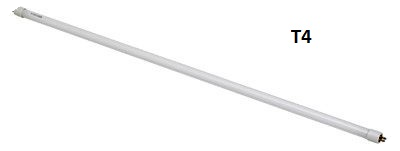 T4 fluorescent tubes are those small fluorescent tubes used under kitchen counters or as a side lighting in many different areas. These lights are not standardized and differ from manufacturer to manufacturer in their sizes and shapes and also wattage’s so be careful if you are buying these. T4 light bulbs have a diameter of 0.5 inch (12.7 mm) so they are even more smaller than T5 lights but they are not more energy efficient and that makes them bad for growing plants. These lights are hard to get, they differ in shapes and they do not have any grow light fixtures and I have not seen anyone growing anything under them but in theory that should be possible and if that is your only choice it could still be better than CFL lights if you get efficient enough bulbs.
T4 fluorescent tubes are those small fluorescent tubes used under kitchen counters or as a side lighting in many different areas. These lights are not standardized and differ from manufacturer to manufacturer in their sizes and shapes and also wattage’s so be careful if you are buying these. T4 light bulbs have a diameter of 0.5 inch (12.7 mm) so they are even more smaller than T5 lights but they are not more energy efficient and that makes them bad for growing plants. These lights are hard to get, they differ in shapes and they do not have any grow light fixtures and I have not seen anyone growing anything under them but in theory that should be possible and if that is your only choice it could still be better than CFL lights if you get efficient enough bulbs.
T4 light efficiency:
-
8 W 11 inch = 490 lumen => 61.9 lumen/watt
-
10 W 13 inch = 480 lumen => 48 lumen/watt
-
16 W 19 inch = 1000 lumen => 62.5 lumen/watt
-
18 W 20 inch = 1300 lumen => 72.2 lumen/watt
-
20 W 21 inch = 1340 lumen => 67 lumen/watt
T2 bulbs
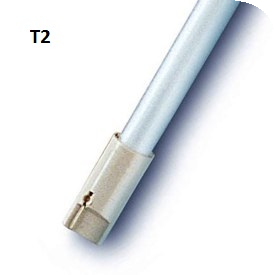 T2 bulbs are the smallest straight fluorescent tubes out there and they are only 1/4 inch (7 mm) thick and that makes them really low profile but also limits them in their wattage’s and sizes. These lights again are used for side lighting and aren’t made for growing and because they have such low wattage’s they won’t be able to grow anything but if you really wanted to use them you would need to have a lot of these bulbs to get proper light intensity. The efficiency ratings are also poor so it would not be feasible to grow anything under them!
T2 bulbs are the smallest straight fluorescent tubes out there and they are only 1/4 inch (7 mm) thick and that makes them really low profile but also limits them in their wattage’s and sizes. These lights again are used for side lighting and aren’t made for growing and because they have such low wattage’s they won’t be able to grow anything but if you really wanted to use them you would need to have a lot of these bulbs to get proper light intensity. The efficiency ratings are also poor so it would not be feasible to grow anything under them!
T2 light efficiency:
-
6 W 10 inch = 228 lumen => 38 lumen/watt
-
8 W 12.5 inch = 540 lumen => 56.2 lumen/watt
-
11 W 16.6 inch = 750 lumen => 68.1 lumen/watt
-
13 W 20.6 inch = 930 lumen => 71 lumen/watt
4 pin (PLL)
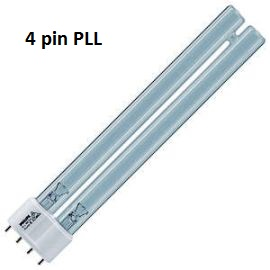 4 pin Fluorescent lights are a form factor that has an outside ballast at one side and usually a curved one or two layer fluorescent tubes. The most well known 4 pin lights are PLL ones as they are basically T5 bulbs folded in half and attached at only one end. These lights are efficient, easy to use and also fairly cheap so they work great as grow lights. I have seen these lights being used in seedling starting and also for the full plant growth from seed to harvest and that is possible because they offer a great efficiency ratings that are only surpassed by T5 and T8 lights. These 4 pin bulbs are compact and they are a better solution for plant growing than the regular CFL bulbs!
4 pin Fluorescent lights are a form factor that has an outside ballast at one side and usually a curved one or two layer fluorescent tubes. The most well known 4 pin lights are PLL ones as they are basically T5 bulbs folded in half and attached at only one end. These lights are efficient, easy to use and also fairly cheap so they work great as grow lights. I have seen these lights being used in seedling starting and also for the full plant growth from seed to harvest and that is possible because they offer a great efficiency ratings that are only surpassed by T5 and T8 lights. These 4 pin bulbs are compact and they are a better solution for plant growing than the regular CFL bulbs!
PLL bulbs are very good for smaller spaces as you can basically get the efficiency of T5 light in half it’s length and that gives these PLL 4 pin lights a great advantage over other light bulbs.Basically for small spaces they are the best choice and I feel they are even better than T5 or T8 fixtures but only if you have small grow space.
PLL light efficiency:
-
18 W = 1200 lumen => 66.6 lumen/watt
-
24 W = 1800 lumen => 75 lumen/watt
-
36 W = 2900 lumen => 80.5 lumen/watt
-
55 W = 4800 lumen => 87.2 lumen/watt
2 Pin (PLC)
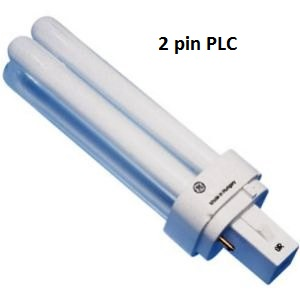 2 pin fluorescent light bulbs are one more standard that is used in indoor lighting and these are also bulbs that need external ballast and they are usually also folded fluorescent tube and sometime look just like a regular CFL bulb. These two pin bulbs are cheaper than CFL lights because they do not have a built in ballast and you need a fixture with that ballast where to put these lights. In the efficiency they are about the same as CFL bulbs but maybe have a bit more lumen per watt output at the same wattage’s so they could be better used for growing purposes. These lights are also compact and don’t require a lot of space so they could be used just like CFL bulbs in smaller growing areas. However you need those specialized fixtures to fit them in and that gives unnecessary problems and I haven’t seen these lights being used for growing and if you are willing to buy specialized fixtures to fit your lights it would be better to buy 4 pin or T5 fixture!
2 pin fluorescent light bulbs are one more standard that is used in indoor lighting and these are also bulbs that need external ballast and they are usually also folded fluorescent tube and sometime look just like a regular CFL bulb. These two pin bulbs are cheaper than CFL lights because they do not have a built in ballast and you need a fixture with that ballast where to put these lights. In the efficiency they are about the same as CFL bulbs but maybe have a bit more lumen per watt output at the same wattage’s so they could be better used for growing purposes. These lights are also compact and don’t require a lot of space so they could be used just like CFL bulbs in smaller growing areas. However you need those specialized fixtures to fit them in and that gives unnecessary problems and I haven’t seen these lights being used for growing and if you are willing to buy specialized fixtures to fit your lights it would be better to buy 4 pin or T5 fixture!
2 pin light efficiency:
-
5 W = 250 lumen => 50 lumen/watt
-
9 W = 600 lumen => 66.6 lumen/watt
-
13 W = 810 lumen => 62.3 lumen/watt
-
18 W = 1200 lumen => 66.6 lumen/watt
-
26 W = 1800 lumen => 69.2 lumen/watt
There are many different types that I did not include in this type review post because they are not feasible for growing plants either because of their shape or inefficiency and basically these types that I did include are the ones most likely used by growers.
That being told I feel that I must pick one type that stands out from others and these are the T5 bulbs as they have the most total efficiency and that is why they are so popular among artificial lights for plants. Because of this factor I also promote you to use T5 light for growing and check out our homepage to see a comparison chart of the best T5 grow light fixtures.
